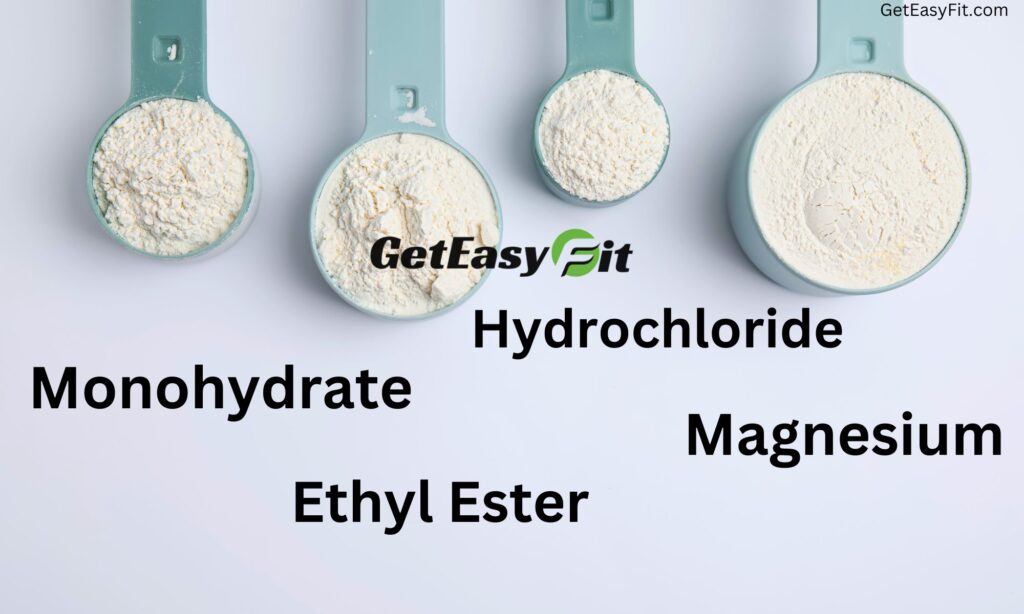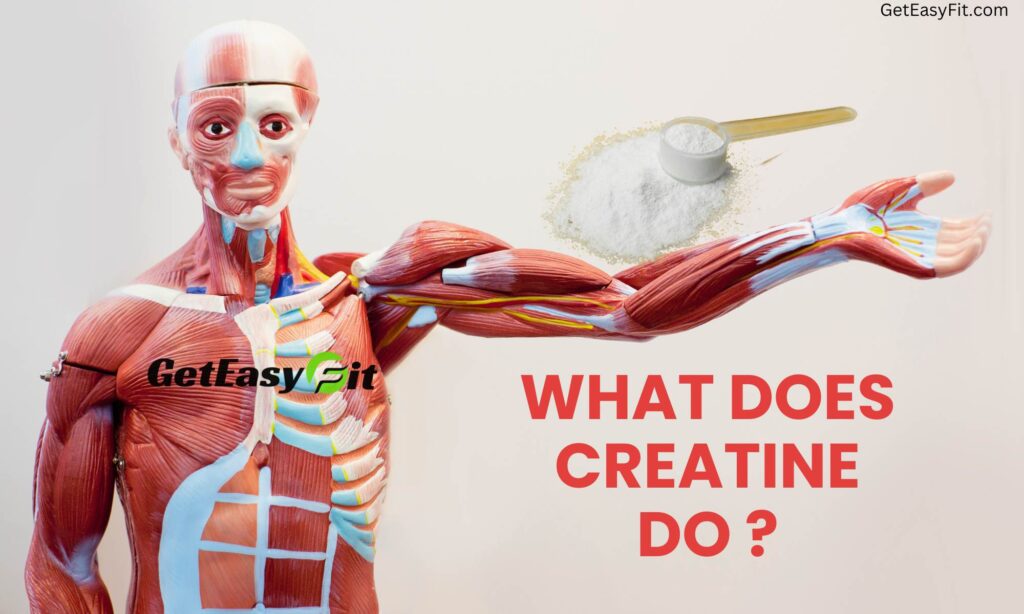Until 1996 creatine was just a known supplement by Scientists that creatine can improve athletic performance. But 80% of the Olympic gold medallists in 1996 Atlanta credited the creatine supplement that creatine has the efficacy to improve athletic performance.
Today, creatine is most popular with every athlete whether it’s a cyclist or a bodybuilder. It is one of the most-rated supplements in terms of selling and consumption.
what is creatine?
Creatine is a special amino acid derivative found mostly in our muscles (about 95%) and a bit in our brain, liver, kidney, and testicles (around 5%).
Most of this creatine in our muscles is in the form of phosphocreatine, and the rest is free creatine[1]. The total amount of creatine in our muscles is like a reserve. To keep our creatine levels normal, our body has to make about 1 to 3 grams of creatine every day. Some of this comes from what we eat, like chicken, fish, and red meat, the rest is made by our body, using ESSENTIAL amino acids like arginine, and methionine, and NON-ESSENTIAL amino acids like glycine[2].
When and why creatine was discovered?
In the 1980s numerous supplements like protein, casein, Omega-3 fatty acid, and creatine were discovered for muscle growth[3]. Creatine is the most important supplement for the metabolism of muscles and the brain and for high energy demand by the body during workouts[4].
Different forms of creatine:
There are many forms of creatine, but Basically, we heard about 6 types of creatine: Creatine Monohydrate, Creatine Ethyl Ester, Creatine Hydrochloride, Buffered Creatine, Liquid Creatine, and Creatine Magnesium chelate.
[ALSO READ THIS: Top Superfoods That Can Help in Weight Loss]
Creatine Monohydrate:
The most commonly used and affordable kind of creatine is creatine monohydrate. This type is made by adding a water molecule to creatine. It’s considered the usual choice and has been studied a lot. A recent review in the Journal of the International Society of Sports Nutrition found that creatine monohydrate is better at affecting the creatine levels in muscles than other types[5].
Creatine Ethyl Ester:
It was made for more bioavailability because, In this type of creatine, Ethyl ester is bound to the creatine molecule.
But in 2009 a 47-day study was done to compare creatine ethyl ester to creatine monohydrate supplementation and a placebo. The results produced by the Creatine ethyl ester did not have any additional benefit to increased muscle strength or performance[6].
Creatine Hydrochloride (HCL):
Creatine is bound to the hydrochloride molecules to increase the solubility and absorption in the system. Creatine Hydrochloride is more acidic because is its lower pH effect. Creatine Hydrochloride is more efficiently absorbed in the body that’s why it needs a low dose compared to creatine monohydrate.
Buffered Creatine:
This is basically alkaline in nature because of the higher pH. This type of protein is buffered with sodium carbonate and sodium bicarbonate which induce alkalinity of the product[7].
Liquid Creatine:
Creatine serum is packed in a pouch and ready to drink. It is not that effective compared to other types of creatine. Less research on this type of creatine has limited the sales of the product[8].
Creatine Magnesium:
Creatine is bound to the magnesium molecule, thought to be well absorbed by the body compared to creatine monohydrate. A scientist has not claimed Creatine Magnesium is as effective as other types of creatine due to a lack of research.
[ALSO READ: Weight Loss Probiotics For Women]
What does creatine do:
When you take creatine, it will be absorbed by the digestive tract of the body. Creatine goes into the muscle and makes creatine phosphate. Creatine phosphate breaks the ATP (adenosine triphosphate) bond and makes ATP into ADP, Which releases energy. The remaining ADP, that is, adenosine diphosphate is formed by the creatine phosphate and again forms ATP[9].
what does creatine do for muscles:
Basically, it is a compound used to replenish ATP in muscles. It does not directly affect your muscle size. Muscle size does look big, but it is because creatine retains water. It is a water weight, water gets filled in muscles which makes you feel that muscle size is increasing but creatine does not directly increase size.
What are the benefits of creatine:
- Improve physical and cognitive performance
- INCREASE the effects of resistance training for enhancing strength and hypertrophy
- Improving the quality and benefits of high-intensity intermittent speed training
- Improving aerobic endurance performance in trials lasting more than 150s
- produce positive effects on strength, power, fat-free mass, daily living performance, and neurological function in young and older people
what are the side effects of creatine:
Creatine can become harmful to your body when it is not taken properly because it absorbs water in the muscles. When it goes inside the muscles, it fills the water in the muscles. There is a limited amount of water in your body that keeps your blood volume. If this water gets absorbed in the muscles, your blood volume decreases. Automatically The heart will get less blood, the brain will get less blood and there is a condition arises called hypotension. Hypotension is a condition in which your BLOOD PRESSURE reduces.
How much monohydrate creatine should I take:
Creatine Monohydrate can be taken 3-5 grams daily, it won’t affect your kidneys. Usually, the dosage of creatine is decided by body weight. More than 5 grams is never exceeded. But usually, if you take up to 3 grams of creatine, it is more than sufficient, unless you are a very big guy or a pro bodybuilder. But if someone’s weight is less, 60-70 kg, then 3 grams of creatine is enough for him.
[READ THIS: Ozempic Diet Meal Plan for weight loss]
How to take creatine monohydrate powder properly:
Creatine causes gastritis, gas formation, and acidity in the stomach. There are two ways to take creatine monohydrate powder properly.
The first way is not to take creatine monohydrate on an empty stomach. Take creatine monohydrate with some food, talking about a small carbohydrate-rich snack. 20 to 30 grams of carbs is more than enough to avoid stomach discomfort and better absorption of creatine monohydrate.
The second way is to take creatine monohydrate in divided doses. If you are taking 3 grams of creatine in a day, then take 1.5 grams in the morning and 1.5 grams in the evening and work out in between, this is best. If you are taking 5 grams, then take 2.5 grams in the morning and 2.5 grams in the evening and work out in between. This will reduce gastritis and the absorption will be better.
creatine for cycling:
People used to think that we cycle creatine so that our kidneys are not damaged or so that we don’t have to put too much pressure on our bodies. creatine does not put pressure on your kidneys if you are drinking water in a proper amount and taking creatine monohydrate in a proper way. So, as such, there is no need to cycle creatine.
As a doctor, I would like to say that if you take any synthetic product from outside, which your body is producing by itself, then its production decreases endogenously. For example, if people take testosterone from outside, synthetic steroids, then their testosterone production decreases. This also happens with creatine. Studies have been done on this as well. It has been found that in people who take creatine externally more than necessary, their body’s production decreases.
Creatine Bodybuilding: Loading phase
When it comes to creatine monohydrate(CM) supplementation plans Traditionally, people went for either a loading phase with 20 to 25 g CM/d or 0.3 g CM/kg/d, spread across 4 to 5 doses of 5 g each, to quickly fill up muscle creatine stores.
But hold on, there’s a more savvy method in town: a moderate approach with numerous smaller doses throughout the day (how about 20 times 1 g every 30 minutes?). This clever technique could lead to the ultimate saturation of those precious intramuscular creatine reserves.
Now, don’t let the gains slip away – after the loading phase, a maintenance period kicks in. This involves 3-5 g CM/d or 0.03 g CM/kg/d to maintain muscle saturation. These tactics are the golden ticket for getting the most out of creatine supplementation and fully embracing its benefits.
But wait, there’s more. Recent studies have uncovered a promising twist: blending Creatine Monohydrate supplementation at 0.1 g/kg body weight with resistance training enhances training adaptations at cellular and sub-cellular levels. To supercharge this, team up creatine intake with carbs and/or protein. This dynamic duo, by boosting insulin secretion, hikes up creatine retention by roughly 25%. The result? A speedier saturation process. Keep in mind, though, this doesn’t necessarily translate to a greater performance boost – it’s all about smart strategy.
Disclaimer:
The content on GetEasyFit is meant to be informative in nature, but it should not be taken as medical advice. The opinions and articles on this site are not intended for use as diagnosis, prevention, and/or treatment of health problems. It’s always a good idea to talk to your doctor before beginning a new fitness, nutritional, and/or supplement routine. None of these supplements are meant to treat or cure any disease. If you feel you may be deficient in a particular nutrient or nutrient, please seek out a medical professional.
References
- Buford T, Kreider R, Stout J, Greenwood M, Campbell B, Spano M, Ziegenfuss T, Lopez H, Landis J, Antonio J. International Society of Sports Nutrition position stand: creatine supplementation and exercise. J Int Soc Sports Nutr. 2007;4:6. doi: 10.1186/1550-2783-4-6.
- van Loon L, Oosterlaar A, Hartgens F, Hesselink M, Snow R, Wagenmakers A. Effects of creatine loading and prolonged creatine supplementation on body composition, fuel selection, sprint and endurance performance in humans. Clin Sci (Lond) 2003;104:153–162.
- Persky A, Brazeau G. Clinical pharmacology of the dietary supplement creatine monohydrate. Pharmacol Rev. 2001;53:161–176.
- Wyss M., Kaddurah-Daouk R. Creatine and creatinine metabolism. Physiol. Rev. 2000;80:1107–1213.
- Kreider R.B., Stout J.R. Creatine in Health and Disease. Nutrients. 2021;13:447. doi: 10.3390/nu13020447.
- Humm A., Fritsche E., Steinbacher S. Structure and reaction mechanism of L-arginine:glycine amidinotransferase. Biol. Chem. 1997;378:193–197.





Thanx for deep knowledge creatine,